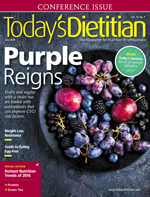 July 2016 Issue
July 2016 Issue
Ask the Expert: Craft and Artisanal Beverages
By Toby Amidor, MS, RD, CDN
Today's Dietitian
Vol. 18 No. 7 P. 9
Q: What are artisanal and craft beverages, and are they healthful?
A: Artisanal and craft beverages include certain varieties of beer, coffee, tea, soda, and other drinks that typically are made in smaller batches or by smaller companies. There are an abundance of artisanal beverages showing up on supermarket shelves. Many people are drawn to these beverages thinking they contain more nutritious ingredients. In fact, many companies promote the ingredients of artisanal beverages as "natural" and/or "organic", leading consumers to believe they're more healthful. It's important for health professionals to be familiar with these food products and help clients understand the Nutrition Facts panel to determine whether the artisanal beverages they choose can be part of a healthful eating plan.
Craft Beer
"There's no formal definition of craft beer," says Joy Dubost, PhD, RD, beer steward at the Master Brewers Association. Back in 1978, there were 89 brewing plants from 42 companies in the United States. Once President Carter signed legislation to allow home brewing, many people without formal training started brewing in their basements and garages, and subsequently began opening their own microbreweries.
Today, while four companies own 80% of the market share for beer, sales of craft beers increased by 12.8%, and production increased 13% in 2015.1 These larger companies acquired some craft beer favorites; for example, Miller Coors owns Blue Moon.
The 2015–2020 Dietary Guidelines for Americans suggest a maximum of two alcoholic drinks per day for men, while women are recommended a maximum of one. A standard drink of beer is defined as 12 fl oz with 5% alcohol by volume (ABV). Many craft beers contain greater than 5% ABV, making 12 fl oz equivalent to more than one drink. Furthermore, many craft beers on tap usually are served in 16-fl oz glasses, which could potentially equate to more than one drink, in light of their ABV. Dubost stresses the importance of understanding how to calculate drink equivalents so practitioners can guide clients on how to regulate their alcohol consumption. It's also interesting to note that "Three of the top four selling beers are light beers, which [contain] 4.2% ABV and equate to 0.8 drink equivalents," Dubost says.
To calculate drink equivalents, use the following equation:
Drink equivalents = (% ABV x fluid ounces consumed)/0.6 fl oz
Craft beers have a unique nutritional profile, including numerous polyphenols, with 70% to 80% coming from the malt and the remaining 20% to 30% coming from the hops. Beer also contains numerous B vitamins and potassium and is very low in sodium. It's also composed of more than 93% water, which helps with hydration.
Other Artisanal Varieties
From cold-brewed coffee to flavored water to craft sodas, there are many beverages on store shelves that consumers may believe are better for them. Unsweetened cold-brewed coffee or teas contain few calories. However, consumers may choose those with flavors or sweeteners, adding unnecessary sugar and calories. Consumers also may believe that sparkling or still artisanal water is calorie-free; however, some companies add sugar to balance the added flavors. The same holds true for craft sodas. Although they may appear to have a "cleaner" label with fewer ingredients and the terms "organic" or "natural" on the label, they're still laden with empty calories from added sugar. Furthermore, many people are still confused about calories per serving. Some bottled beverages contain 1.5 or two servings, and consumers don't always comprehend the concept of multiplying the calories per serving if they consume the entire bottle.
Kombucha, or fermented tea, is an artisanal beverage touted for many therapeutic benefits, like detoxification. There's no evidence of such a benefit; however, fermented foods do provide live and active cultures that can act as probiotics. Kombucha also contains sugar, B vitamins, antioxidants (from the tea), and a trace amount of alcohol due to the fermentation. Many home-brewed kombuchas are unpasteurized, which can cause foodborne illness. Recommend clients choose store-bought pasteurized varieties.
The Practitioner's Role
As many new beverages, with and without alcohol, appear on store shelves, the role of nutrition professionals is to teach consumers how to read the Nutrition Facts panel, including the ingredient list. Clients may feel the added sugar used in these beverages (eg, blackstrap molasses, beet sugar, and raw sugar) is better for them, but RDs should explain that they're still considered empty calories from added sugar. With craft beers, it's important to explain the ABV for beer and help clients determine how many drink equivalents they're really consuming. For further information on determining drink equivalents on alcoholic beverages, refer to Appendix 9 of the 2015–2020 Dietary Guidelines for Americans.2
— Toby Amidor, MS, RD, CDN, is the founder of Toby Amidor Nutrition (http://tobyamidornutrition.com) and the author of the cookbook The Greek Yogurt Kitchen: More Than 130 Delicious, Healthy Recipes for Every Meal of the Day. She's also a nutrition expert for FoodNetwork.com and a contributor to US News Eat + Run, Shape.com, and MensFitness.com.
References
1. National beer sales & production data. Brewers Association website. https://www.brewersassociation.org/statistics/national-beer-sales-production-data/. Accessed May 8, 2016.
